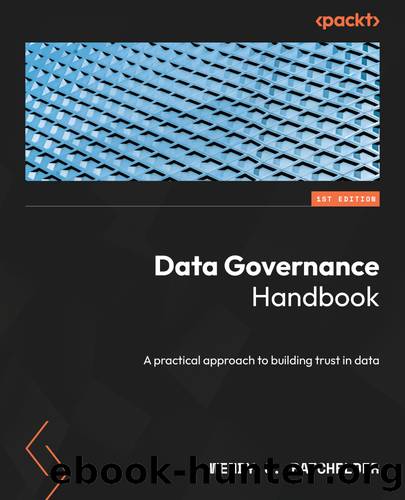Data Governance Handbook by Wendy S. Batchelder

Author:Wendy S. Batchelder
Language: eng
Format: epub
Publisher: Packt Publishing Pvt Ltd
Published: 2024-05-22T00:00:00+00:00
The value of measuring data quality
I have no doubt youâve experienced this if youâve been in a data role for more than a day: Someone reaches out to you, convinced that their data is âwrong.â They want it fixed. Ultimately, what they are saying to you is: I donât trust this data.
When we think about measuring the value of data quality, we have to challenge ourselves to think more broadly than one might expect to. When we are thinking about how to measure the value of data quality, we are really asking: How do I measure the value of trust? What does it mean to my company to be able to trust the information we use for decision-making, every single day? What is it worth to us to know we can trust the information being used to run our business? To drive value for our customers? To operate effectively? If you could place a dollar value on that, what would it be?
The value of trust in our data is highly dependent on your business. Letâs start with a real-life example.
Building trust in data quality
Marketing is a function in a company that many do not necessarily correlate with data, but in my experience, the best marketing functions are highly data-driven. I worked with a marketing department that was struggling to understand which individuals they could market to. They had a plethora of lead data, but they were having a hard time determining the following:
Which leads had accurate email addresses and quality data
If the leads had consented to marketing holistically or for only specific products (further complicated by M&A)
If the most recent consent was valid for their countryâs regulations (for example, how long is the consent valid for?)
Ultimately, the Chief Marketing Officer needed to measure how much the marketing team was contributing to sales, but without quality lead information that they could trust, measuring the impact of marketing on sales was very difficult. They believed their team was contributing more than they were able to measure, but they couldnât prove that with data.
At the beginning of the process to improve the trustworthiness of the marketing lead data, we baselined the quality of the data by completing basic data profiling based on what was determined to be âkey fields.â We defined key fields as the fields associated with a contact record that were required to be able to market to that contact, which included: first name, last name, email address, company, and valid consent. Our initial profiling put the quality of these key fields at about 43%, meaning only about 43% of the contacts had reliable data in these five fields.
We deployed an enrichment service to be able to improve the reliability of the contact data. It allowed us to overwrite low-quality data (such as initials in fields for first name and last name, and fill in blanks), and to validate email addresses with a third-party service. This improved leads where the address had been typed incorrectly. Therefore, we were able to take instances where we had consent but an invalid email address and use the email address.
Download
This site does not store any files on its server. We only index and link to content provided by other sites. Please contact the content providers to delete copyright contents if any and email us, we'll remove relevant links or contents immediately.
| Access | Data Mining |
| Data Modeling & Design | Data Processing |
| Data Warehousing | MySQL |
| Oracle | Other Databases |
| Relational Databases | SQL |
Algorithms of the Intelligent Web by Haralambos Marmanis;Dmitry Babenko(9832)
Azure Data and AI Architect Handbook by Olivier Mertens & Breght Van Baelen(7617)
Building Statistical Models in Python by Huy Hoang Nguyen & Paul N Adams & Stuart J Miller(7598)
Serverless Machine Learning with Amazon Redshift ML by Debu Panda & Phil Bates & Bhanu Pittampally & Sumeet Joshi(7483)
Data Wrangling on AWS by Navnit Shukla | Sankar M | Sam Palani(7239)
Driving Data Quality with Data Contracts by Andrew Jones(7236)
Machine Learning Model Serving Patterns and Best Practices by Md Johirul Islam(6966)
Learning SQL by Alan Beaulieu(6211)
Weapons of Math Destruction by Cathy O'Neil(6146)
Big Data Analysis with Python by Ivan Marin(5886)
Data Engineering with dbt by Roberto Zagni(4900)
Solidity Programming Essentials by Ritesh Modi(4529)
Time Series Analysis with Python Cookbook by Tarek A. Atwan(4363)
Pandas Cookbook by Theodore Petrou(4061)
Blockchain Basics by Daniel Drescher(3507)
Natural Language Processing with Java Cookbook by Richard M. Reese(3102)
Hands-On Machine Learning for Algorithmic Trading by Stefan Jansen(3027)
Feature Store for Machine Learning by Jayanth Kumar M J(2908)
Learn T-SQL Querying by Pam Lahoud & Pedro Lopes(2881)
